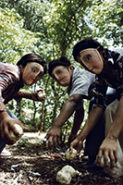In the late 1970s, Susan Meiselas—then a new member of Magnum Photos, an artist-owned agency and standard bearer for the postwar field of photojournalism—traveled to Nicaragua, where she documented the Sandinista uprising against the government’s autocratic regime. A selection of her photographs, many published in international newspapers and magazines of the time, was exhibited here as a riveting testament to the impending coup and its aftermath. Meiselas’s series balances fidelity to sociopolitical context with attention to the volatility of visual signs—a quality more commonly associated with postmodernist photography than with the evidentiary claims of documentary. Her archive of the Nicaraguan revolution often flouts the separation between reality and representation, proving that history happens in and through the world of images.
The exhibition of her work at Higher Pictures opened with an object lesson in real-world image mediation. Meiselas’s most famous picture, Sandinistas at the walls of the National Guard headquarters, with ‘Bareta’ Pablo Jesús Aráuz, known as the ‘Molotov Man’, Estelí, Nicaragua, July 16th, 1979, captures a Pepsi bottle aflame in the clenched, retracted fist of a Sandinista rebel. The photograph documents the climax of an insurrection that ultimately deposed the decades-long Somoza family dictatorship and installed a socialist government. After the revolution, Molotov Man’s defiant gesture morphed into a popular motif in Nicaragua and beyond, appearing in stenciled graffiti, folk monuments, and liberation-front propaganda, as well as in fearmongering tracts designed to rally anti-Communist sentiment in the US. (In 2004, the painter Joy Garnett’s appropriation of Meiselas’s photo sparked a controversy over fair use in the American art world. When Garnett consented to Meiselas’s request to remove the work’s image from her website, an international network of artists circulated their own “copyfight” appropriations of the Molotov Man in protest.) Alongside Meiselas’s original photo in this exhibition, the iconic freedom fighter reappeared in painted form within a Nicaraguan street mural that Meiselas shot in 1986. A third photo recorded the same wall in 1991, after the US-backed Contra War that led to the electoral upset of the Sandinista regime. In this iteration, the once-incendiary tableau is overpainted in slate gray, and the militant is reduced to a tenuous silhouette.
The human figure often takes on allegoric dimensions in Meiselas’s works, in which the image world elaborates rather than obfuscates the stakes of the insurgency. Faces are often rendered indirectly: in profile, in shadow, or via proxies and displacements. In Marketplace in Diriamba, Nicaragua, 1978, a crouching boy trains his disquieted gaze on a handful of plastic toy soldiers held aloft by a street vendor. This ominous identification of child with combatant became explicit in another photo, in which three adolescents wearing the mesh masks of local indigenous carnival traditions confront the camera at close range, clutching homemade explosives.
Compositional parallels between and within Meiselas’s images underscore relations of power and class. In one photo, dictator Anastasio Somoza Debayle appeared amid an assembly of white-suited government elites, whose diagonal arrangement echoes the military formation behind them. A trenchant counterpart to this work showed civilians lined up against a bus, hands up and backs to the camera as they comply with a government search. Two other photos employed compressed visual fields to document opposite ideological factions. In one, National Guard recruits filed by an oversize, high-contrast photo of Somoza, conflating the head of state with his surrogates. The other showed an energetic phalanx of student protesters emerging as a cluster of faces and fists behind a pro-Sandinista banner. Meiselas frames the demonstrators so we see them only from the neck up, her composition echoing that of the striking headshot they carry aloft, a tribute to Arlen Siu, one of the revolution’s first female martyrs. This image within an image tangles the semiotics of the photo, creating equivalences between individual and cause, past losses and ongoing struggle.
Lifeless bodies in Meiselas’s images lend even deeper gravitas to her other figural transpositions from flesh to archetype, affect to outline. One of her most harrowing photographs, on view here, is of a corpse truncated at the hips, its spinal column exposed, lying in a verdant landscape. Another evoked violence through absence, showing a pointed graffito scrawled on a Somoza supporter’s home: DONDE ESTA NORMAN GONZÁLES / QUE CONTESTE LA DICTADURA. (Where is Norman Gonzáles / the dictatorship must answer). Even in these images, Meiselas refuses spectacles of pain, emphasizing the contingency of her revolutionary subjects—and of their social order.

